Infor Data Lake Connector for TableauInfor Data Lake Connector lets you connect to the Infor Data Lake within the Infor Data Fabric, allowing you to access and utilize your organization's comprehensive data assets. In this article you will learn how to quickly and efficiently integrate Infor Data Lake data in Tableau without coding. We will use high-performance Infor Data Lake Connector to easily connect to Infor Data Lake and then access the data inside Tableau. Let's follow the steps below to see how we can accomplish that! Infor Data Lake Connector for Tableau is based on ZappySys JDBC Bridge Driver which is part of ODBC PowerPack. It is a collection of high-performance ODBC drivers that enable you to integrate data in SQL Server, SSIS, a programming language, or any other ODBC-compatible application. ODBC PowerPack supports various file formats, sources and destinations, including REST/SOAP API, SFTP/FTP, storage services, and plain files, to mention a few. |
Connect to Infor Data Lake in other apps
|
Prerequisites
Before we begin, make sure you meet the following prerequisite:
-
Java 8 Runtime Environment (JRE) installed. It is recommended to use these distributions:
Download Infor Data Lake JDBC driver
To connect to Infor Data Lake in Tableau, you will have to download JDBC driver for it, which we will use in later steps. Let's perform these little steps right away:
- Visit Infor Data Lake video tutorial or official website.
-
Follow the instructions there, download the JDBC driver, and save it locally,
e.g. to
D:\Drivers\JDBC\infor-compass-jdbc.jar.It is recommended to use JDBC driver compiled for Java 8, if possible. -
Then download ION API file from Infor
and place it in the same directory as the JDBC driver, e.g.
D:\Drivers\JDBC\Infor Compass JDBC Driver.ionapi.Do not renameInfor Compass JDBC Driver.ionapifile as it will fail to load the driver. Also, JDBC driver and ION API file have to reside in the same folder for the driver to work. - Done! That was easy, wasn't it? Let's proceed to the next step.
Create Data Source in ZappySys Data Gateway based on JDBC Bridge Driver
-
Download and install ODBC PowerPack.
-
Search for gateway in start menu and Open ZappySys Data Gateway:

-
Go to Users Tab to add our first Gateway user. Click Add; we will give it a name tdsuser and enter password you like to give. Check Admin option and click OK to save. We will use these details later when we create linked server:

-
Now we are ready to add a data source. Click Add, give data source a name (Copy this name somewhere, we will need it later) and then select Native - ZappySys JDBC Bridge Driver. Finally, click OK. And it will create the Data Set for it and open the ZS driver UI.
InforDataLakeDSNNative - ZappySys JDBC Bridge Driver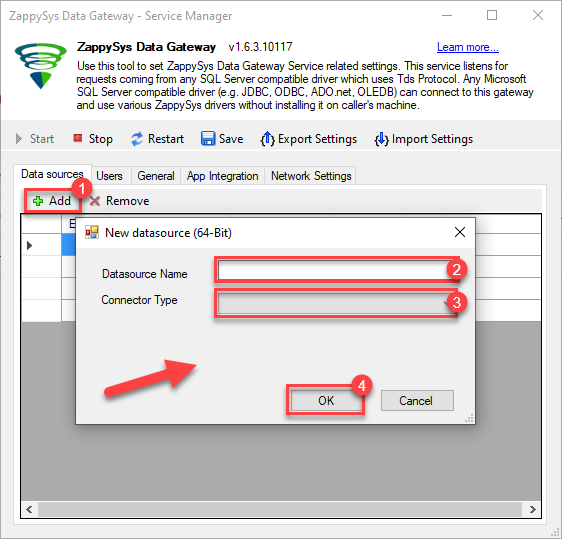
-
Now, we need to configure the JDBC connection in the new ODBC data source. Simply enter the Connection string, credentials, configure other settings, and then click Test Connection button to test the connection:
InforDataLakeDSNjdbc:infordatalake://MY_DATALAKE_IDcom.infor.idl.jdbc.DriverD:\Drivers\JDBC\infor-compass-jdbc.jarjohn.smith@my-company.com*********[]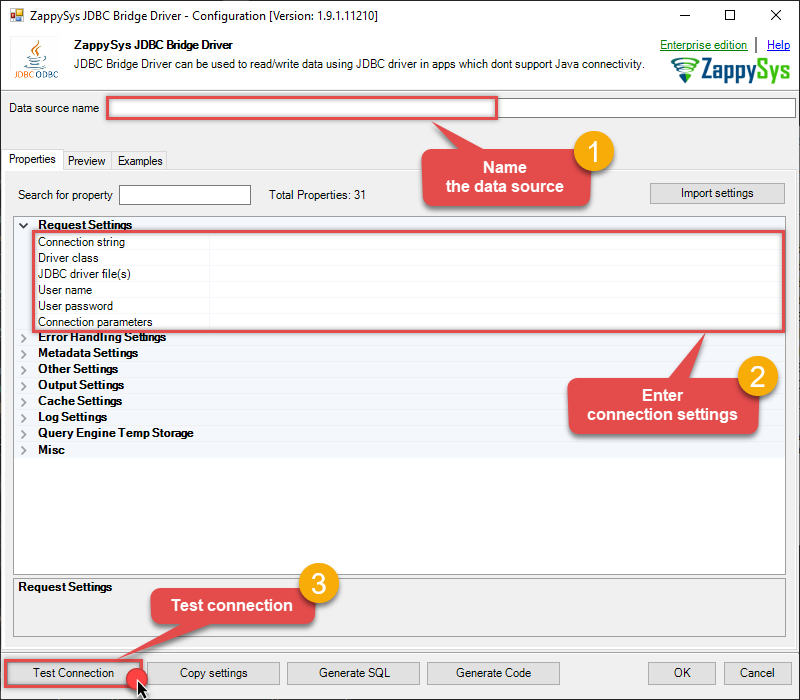
Use these values when setting parameters:
-
Connection string :jdbc:infordatalake://MY_DATALAKE_ID -
Driver class :com.infor.idl.jdbc.Driver -
JDBC driver file(s) :D:\Drivers\JDBC\infor-compass-jdbc.jar -
User name :john.smith@my-company.com -
User password :********* -
Connection parameters :[]
-
-
You should see a message saying that connection test is successful:
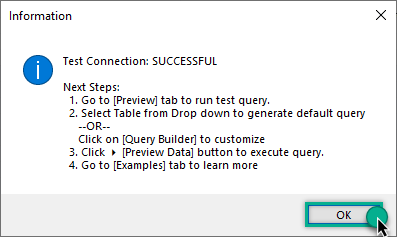
Otherwise, if you are getting an error, check out our Community for troubleshooting tips.
-
We are at the point where we can preview a SQL query. For more SQL query examples visit JDBC Bridge documentation:
InforDataLakeDSNSELECT * FROM "default"."orders"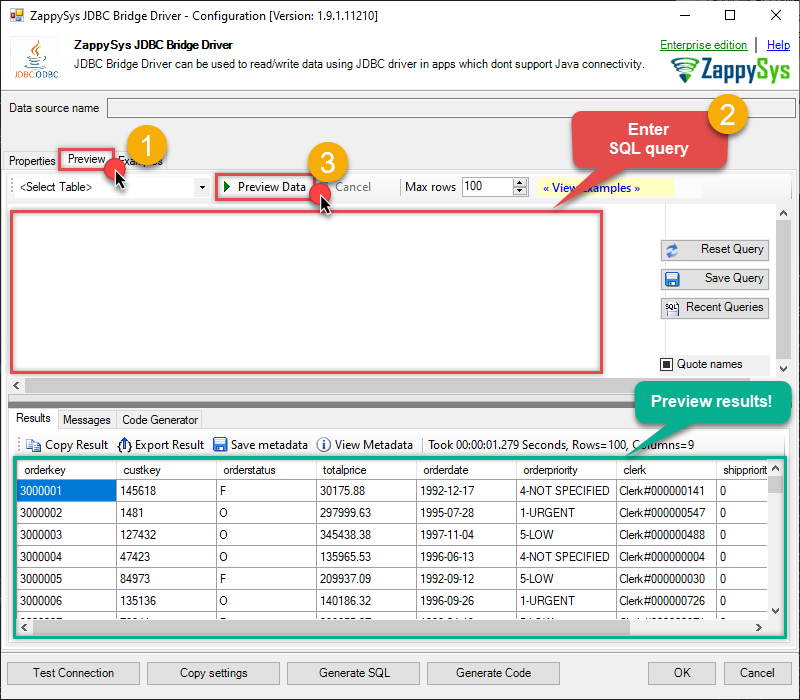
SELECT * FROM "default"."orders"You can also click on the <Select Table> dropdown and select a table from the list.The ZappySys JDBC Bridge Driver acts as a transparent intermediary, passing SQL queries directly to the Trino JDBC driver, which then handles the query execution. This means the Bridge Driver simply relays the SQL query without altering it.
Some JDBC drivers don't support
INSERT/UPDATE/DELETEstatements, so you may get an error saying "action is not supported" or a similar one. Please, be aware, this is not the limitation of ZappySys JDBC Bridge Driver, but is a limitation of the specific JDBC driver you are using. -
Click OK to finish creating the data source.
Read data in SQL Server using ZappySys Data Gateway
To read the data in SQL Server, the first thing you have to do is create a Linked Server:
-
First, let's open SQL Server Management Studio, create a new Linked Server, and start configuring it:
LS_TO_INFOR_DATA_LAKE_IN_GATEWAYMicrosoft OLE DB Driver for SQL Serverlocalhost,5000InforDataLakeDSNInforDataLakeDSN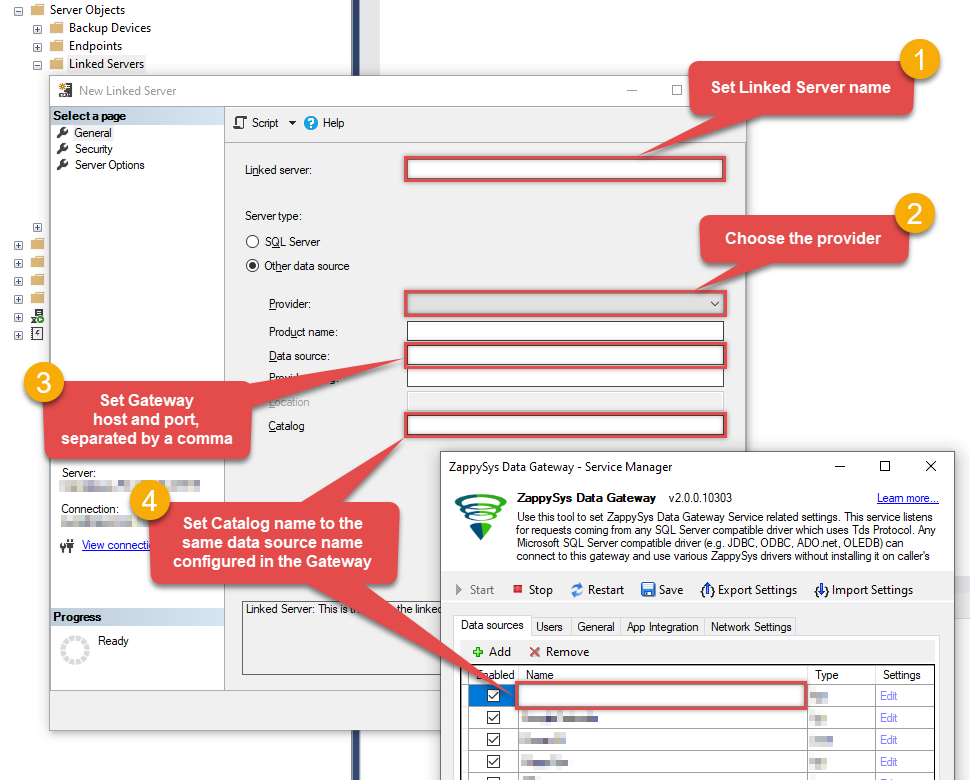 Choose SQL Server Native Client 11.0 as Provider if you don't see the option shown above.
Choose SQL Server Native Client 11.0 as Provider if you don't see the option shown above. -
Then click on Security option and configure username we created in ZappySys Data Gateway in one of the previous steps:
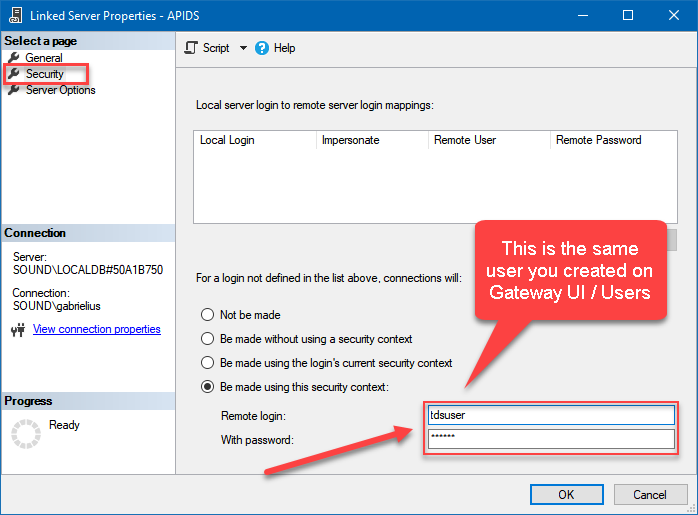
-
Optional step. Under the Server Options, Enable RPC and RPC Out and Disable Promotion of Distributed Transactions(MSDTC).
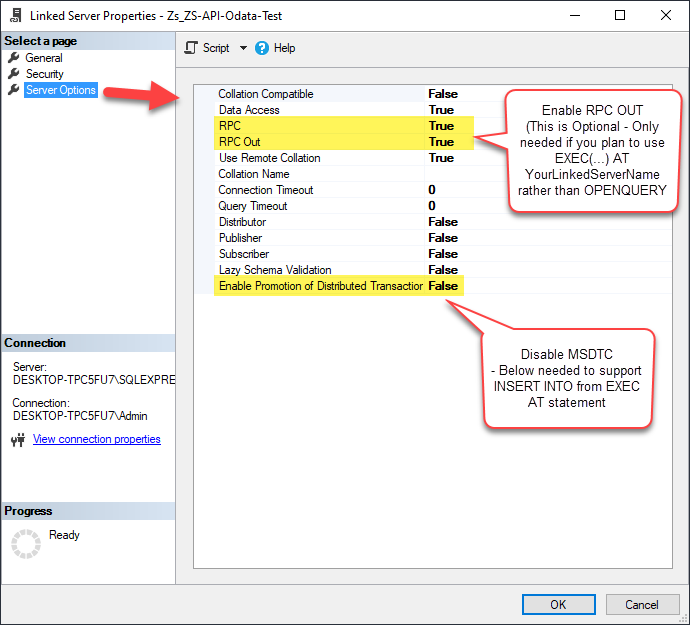
You need to enable RPC Out if you plan to use
EXEC(...) AT [LS_TO_INFOR_DATA_LAKE_IN_GATEWAY]rather than OPENQUERY.
If don't enabled it, you will encounter theServer 'LS_TO_INFOR_DATA_LAKE_IN_GATEWAY' is not configured for RPCerror.Query Example:
EXEC('SELECT * FROM "default"."orders"') AT [LS_TO_INFOR_DATA_LAKE_IN_GATEWAY]
If you plan to use
'INSERT INTO <TABLE> EXEC(...) AT [LS_TO_INFOR_DATA_LAKE_IN_GATEWAY]'in that case you need to Disable Promotion of Distributed Transactions(MSDTC).
If don't disabled it, you will encounter theThe operation could not be performed because OLE DB provider "SQLNCLI11" for linked server "MY_LINKED_SERVER_NAME" was unable to begin a distributed transaction.error.Query Example:
INSERT INTO dbo.Products EXEC('SELECT * FROM "default"."orders"') AT [LS_TO_INFOR_DATA_LAKE_IN_GATEWAY] -
Finally, open a new query and execute a query we saved in one of the previous steps:
SELECT * FROM OPENQUERY([LS_TO_INFOR_DATA_LAKE_IN_GATEWAY], 'SELECT * FROM "default"."orders"')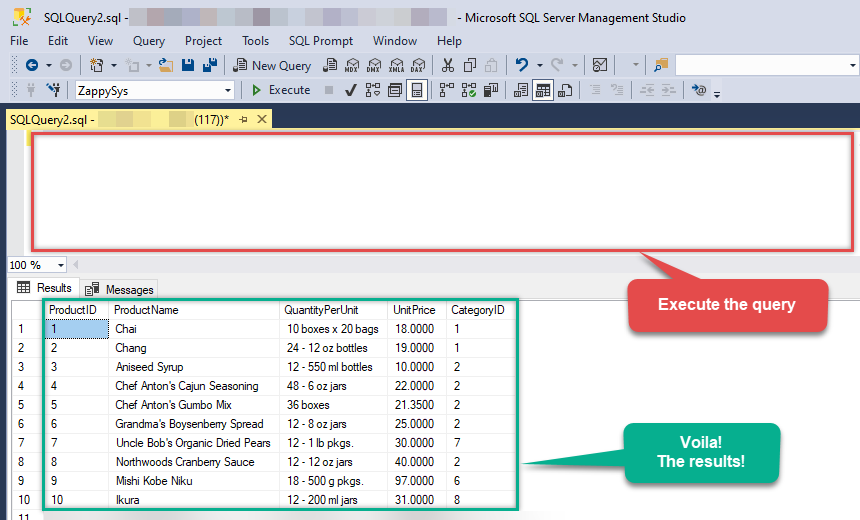
SELECT * FROM OPENQUERY([LS_TO_INFOR_DATA_LAKE_IN_GATEWAY], 'SELECT * FROM "default"."orders"')
Create Linked Server using Code
In previous section you saw how to create a Linked Server from UI. You can do similar action by code too (see below). Run below script after changing necessary parameters. Assuming your Data Source name on ZappySys Data Gateway UI is 'InforDataLakeDSN'USE [master]
GO
--///////////////////////////////////////////////////////////////////////////////////////
--Run below code in SSMS to create Linked Server and use ZappySys Drivers in SQL Server
--///////////////////////////////////////////////////////////////////////////////////////
-- Replace YOUR_GATEWAY_USER, YOUR_GATEWAY_PASSWORD
-- Replace localhost with IP/Machine name if ZappySys Gateway Running on different machine other than SQL Server
-- Replace Port 5000 if you configured gateway on a different port
--1. Configure your gateway service as per this article https://zappysys.com/links?id=10036
--2. Make sure you have SQL Server Installed. You can download FREE SQL Server Express Edition from here if you dont want to buy Paid version https://www.microsoft.com/en-us/sql-server/sql-server-editions-express
--Uncomment below if you like to drop linked server if it already exists
--EXEC master.dbo.sp_dropserver @server=N'LS_TO_INFOR_DATA_LAKE_IN_GATEWAY', @droplogins='droplogins'
--3. Create new linked server
EXEC master.dbo.sp_addlinkedserver
@server = N'LS_TO_INFOR_DATA_LAKE_IN_GATEWAY' --Linked server name (this will be used in OPENQUERY sql
, @srvproduct=N''
---- For MSSQL 2012,2014,2016 and 2019 use below (SQL Server Native Client 11.0)---
, @provider=N'SQLNCLI11'
---- For MSSQL 2022 or higher use below (Microsoft OLE DB Driver for SQL Server)---
--, @provider=N'MSOLEDBSQL'
, @datasrc=N'localhost,5000' --//Machine / Port where Gateway service is running
, @provstr=N'Network Library=DBMSSOCN;'
, @catalog=N'InforDataLakeDSN' --Data source name you gave on Gateway service settings
--4. Attach gateway login with linked server
EXEC master.dbo.sp_addlinkedsrvlogin
@rmtsrvname=N'LS_TO_INFOR_DATA_LAKE_IN_GATEWAY' --linked server name
, @useself=N'False'
, @locallogin=NULL
, @rmtuser=N'YOUR_GATEWAY_USER' --enter your Gateway user name
, @rmtpassword='YOUR_GATEWAY_PASSWORD' --enter your Gateway user's password
GO
--5. Enable RPC OUT (This is Optional - Only needed if you plan to use EXEC(...) AT YourLinkedServerName rather than OPENQUERY
EXEC sp_serveroption 'LS_TO_INFOR_DATA_LAKE_IN_GATEWAY', 'rpc', true;
EXEC sp_serveroption 'LS_TO_INFOR_DATA_LAKE_IN_GATEWAY', 'rpc out', true;
--Disable MSDTC - Below needed to support INSERT INTO from EXEC AT statement
EXEC sp_serveroption 'LS_TO_INFOR_DATA_LAKE_IN_GATEWAY', 'remote proc transaction promotion', false;
--Increase query timeout if query is going to take longer than 10 mins (Default timeout is 600 seconds)
--EXEC sp_serveroption 'LS_TO_INFOR_DATA_LAKE_IN_GATEWAY', 'query timeout', 1200;
GOCreate View in SQL Server
Finally, use this or similar query in a view or stored procedure, which you will be able to use in Tableau. We will create a view to return invoices:
-
CREATE VIEW vwApiInvoices AS SELECT * FROM OPENQUERY([LS_TO_INFOR_DATA_LAKE_IN_GATEWAY], 'SELECT * FROM Invoices')
Read data in Tableau from SQL Server
Actually, we will be getting data from SQL Server which in turn will be getting data from ZappySys Data Gateway data source. Let's begin and see how to accomplish that:
- Open Tableau Desktop and click File > New
-
To create new Connection click More > Microsoft SQL Server > Enter your credentials to connect to SQL Server (in our example before we used tdsuser):
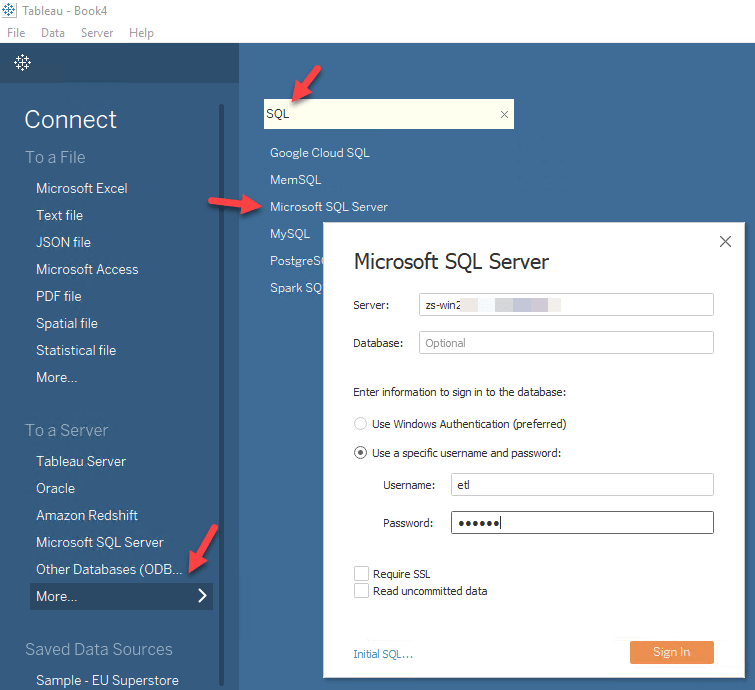
-
Once connection is created for SQL Server we can read Infor Data Lake data 3 different ways:
- Query View which contains OPENQUERY to Linked Server for Infor Data Lake data
- Use direct SQL Query using OPENQUERY
- Use Stored Procedure (Mostly useful to parameterize calls
-
See below example to pull data from Infor Data Lake in Tableau using SQL View approach:
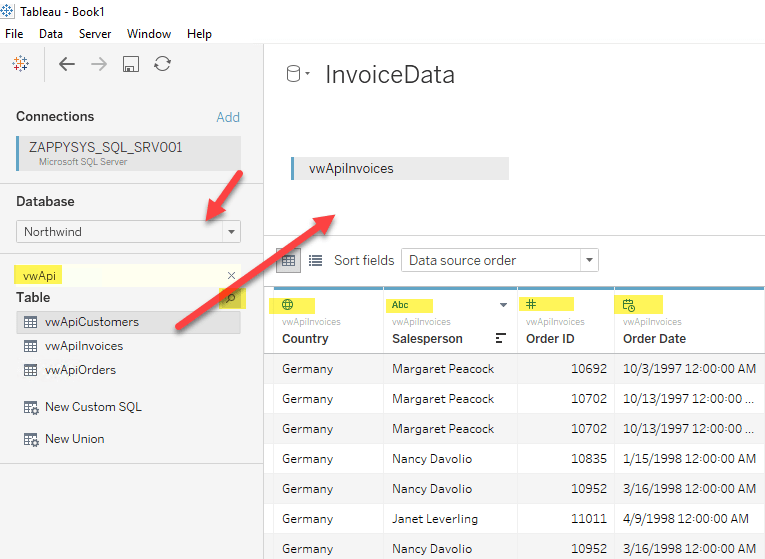
-
Once your data sources are created you can click on Sheet1 and drag fields to create visualizations for Tableau Dashboard:
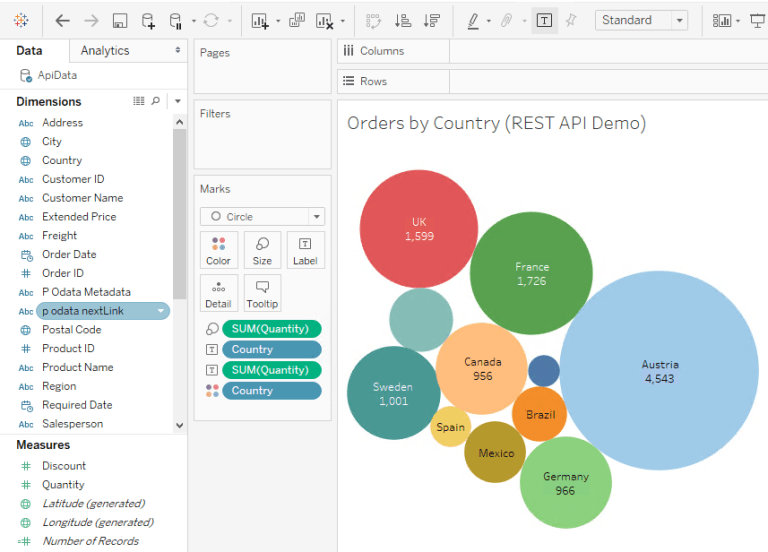
Passing Parameters to Infor Data Lake calls in Tableau (Dynamic SQL)
Now let's look at scenario where you have to pass parameters to build Dynamic Dashboard. You can try to insert Parameters in your Direct SQL when you build Dynamic SQL but we found some issues with that so we are going to suggest Stored Procedure approach. For more information on Known issue on Dynamic Metadata Check this post.-
First lets create a stored procedure in SQL Server for Parameter Example. Notice how we added WITH RESULT SETS in the code to describe metadata.
--DROP PROC dbo.usp_GetInvoicesByCountry --GO /* Purpose: Parameterize Infor Data Lake call via SQL. Call ZappySys Drivers inside SQL Server. */ CREATE PROC dbo.usp_GetInvoicesByCountry @country varchar(100) AS DECLARE @sql varchar(max) --//Escape single ticks carefully SET @sql = 'SELECT OrderID,CustomerID,Country,Quantity FROM $ WITH (Src=''https://services.odata.org/V3/Northwind/Northwind.svc/Invoices?$format=json@filter=Country eq '+ @country +''' ,Filter=''$.value[*]'' ,DataFormat=''OData'' )' DECLARE @sqlFull varchar(max) SET @sqlFull='SELECT * FROM OPENQUERY([LS_TO_INFOR_DATA_LAKE_IN_GATEWAY], ''' + REPLACE( @sql, '''', '''''' ) + ''' )' PRINT @sqlFull --//For DEBUG purpose EXECUTE (@sqlFull) WITH RESULT SETS ( (OrderID int,CustomerID varchar(100),Country varchar(100),Quantity int) --//describe first result. If you don't do this then wont work in Tableau ) GO -- Example call EXEC dbo.usp_GetInvoicesByCountry @country='Germany' - Once you create a stored procedure go to Tableau datasource and select Database which contains the stored procedure we just created.
-
Now find your stored proc and drag it on the datasource pane. You will see parameters UI as below. You can create new parameter - Select New Parameter under Value Column.
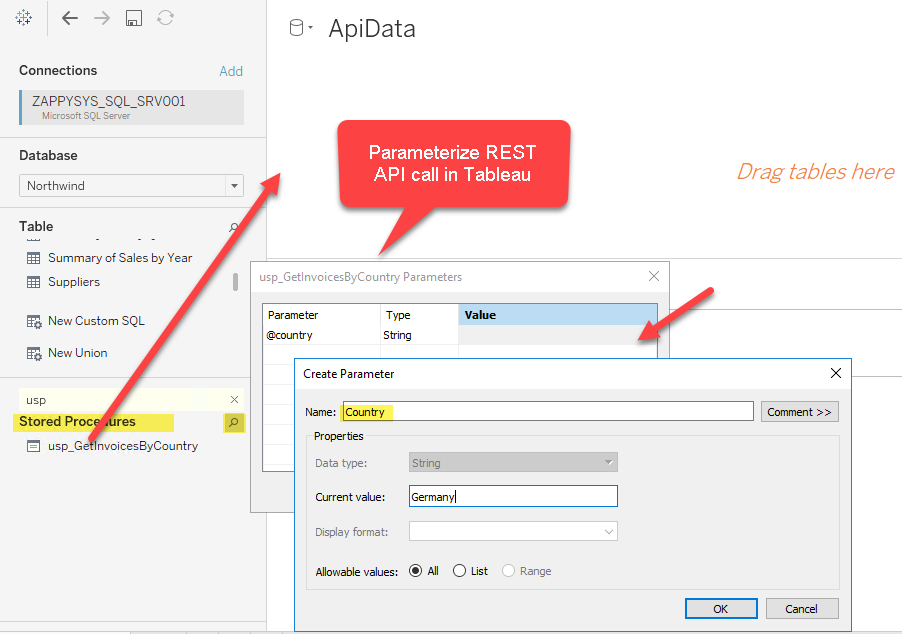
- Thats it now you can reuse your parameterized datasource anywhere in Dashboard.
-
If you have need to select Parameters from predefined values rather than free text then edit your parameter and select List option. Define values you like to select from as below.
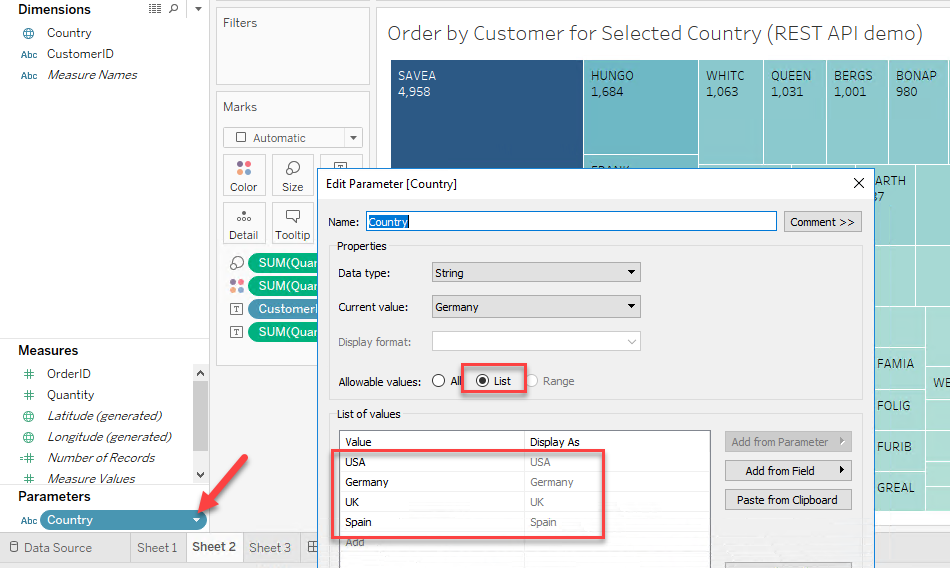
-
When you create Tableau Dashboard you will see Parameter dropdown (If you selected List) elase you may see Textbox to enter custom value.

Firewall settings
So far we have assumed that Gateway is running on the same machine as SQL Server. However there will be a case when ZappySys ODBC PowerPack is installed on a different machine than SQL Server. In such case you may have to perform additional Firewall configurations. On most computers firewall settings wont allow outside traffic to ZappySys Data Gateway. In such case perform following steps to allow other machines to connect to Gateway.
Method-1 (Preferred)If you are using newer version of ZappySys Data Gateway then adding firewall rule is just a single click.
- Search for gateway in start menu and open ZappySys Data Gateway.
- Go to Firewall Tab and click Add Firewall Rule button like below. This will create Firewall rule to all Inbound Traffic on Port 5000 (Unless you changed it).
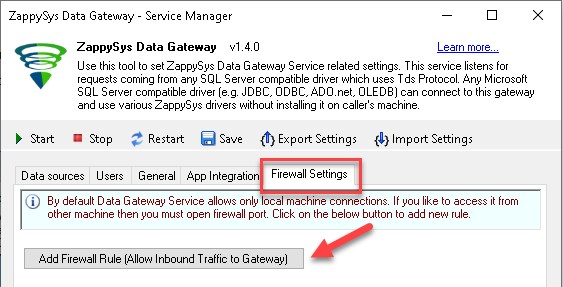
- Search for Windows Firewall Advanced Security in start menu.
- Under Inbound Rules > Right click and click [New Rule] >> Click Next
- Select Port on Rule Type >> Click Next
- Click on TCP and enter port number under specified local port as 5000 (use different one if you changed Default port) >> Click Next
- Select Profile (i.e. Private, Public) >> Click Next
- Enter Rule name [i.e. ZappySys Data Gateway – Allow Inbound ] >> Click Next
- Click OK to save the rule
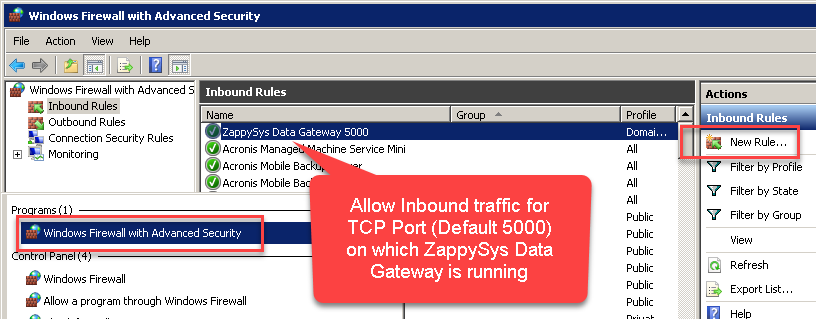
Conclusion
In this article we showed you how to connect to Infor Data Lake in Tableau and integrate data without any coding, saving you time and effort. It's worth noting that ZappySys JDBC Bridge Driver allows you to connect not only to Infor Data Lake, but to any Java application that supports JDBC (just use a different JDBC driver and configure it appropriately).
We encourage you to download Infor Data Lake Connector for Tableau and see how easy it is to use it for yourself or your team.
If you have any questions, feel free to contact ZappySys support team. You can also open a live chat immediately by clicking on the chat icon below.
Download Infor Data Lake Connector for Tableau Documentation
More integrations
Other connectors for Tableau
Other application integration scenarios for Infor Data Lake
How to connect Infor Data Lake in Tableau?
How to get Infor Data Lake data in Tableau?
How to read Infor Data Lake data in Tableau?
How to load Infor Data Lake data in Tableau?
How to import Infor Data Lake data in Tableau?
How to pull Infor Data Lake data in Tableau?
How to push data to Infor Data Lake in Tableau?
How to write data to Infor Data Lake in Tableau?
How to POST data to Infor Data Lake in Tableau?
Call Infor Data Lake API in Tableau
Consume Infor Data Lake API in Tableau
Infor Data Lake Tableau Automate
Infor Data Lake Tableau Integration
Integration Infor Data Lake in Tableau
Consume real-time Infor Data Lake data in Tableau
Consume real-time Infor Data Lake API data in Tableau
Infor Data Lake ODBC Driver | ODBC Driver for Infor Data Lake | ODBC Infor Data Lake Driver | SSIS Infor Data Lake Source | SSIS Infor Data Lake Destination
Connect Infor Data Lake in Tableau
Load Infor Data Lake in Tableau
Load Infor Data Lake data in Tableau
Read Infor Data Lake data in Tableau
Infor Data Lake API Call in Tableau







































































